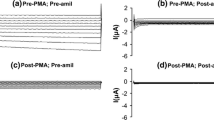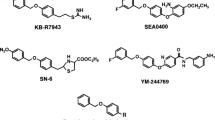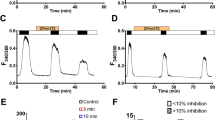Abstract
The three subunits (α, β, γ) encoding for the rat epithelial Na+ channel (rENaC) were expressed in Xenopus oocytes, and the induced Na+ conductance was tested for its sensitivity to various triamterene derivatives. Triamterene blocked rENaC in a voltage-dependent manner, and was 100-fold less potent than amiloride at pH 7.5. At −90mV and −40mV, the IC50 values were 5 μM and 10 μM, respectively. The blockage by triamterene, which is a weak base with a pKa of 6.2, was dependent on the extracellular pH. The IC50 was 1 μM at pH 6.5 and only 17 μM at pH 8.5, suggesting that the protonated compound is more potent than the unprotonated one. According to a simple kinetic analysis, the apparent inhibition constants at −90mV were 0.74 μM for the charged and 100.6 μM for the uncharged triamterene. The main metabolite of triamterene, p-hydroxytriamterene sulfuric acid ester, inhibited rENaC with an approximately twofold lower affinity. Derivatives of triamterene, in which the p-position of the phenylmoiety was substituted by acidic or basic residues, inhibited rENaC with IQ50 values in the range of 0.1–20 μM. Acidic and basic triamterenes produced a rENaC blockade with a similar voltage and pH dependence as the parent compound, suggesting that the pteridinemoiety of triamterene is responsible for that characteristic. Expression of the rENaC α-subunit-deletion mutant, Δ278–283, which lacks a putative amiloride-binding site, induced a Na+ channel with a greatly reduced affinity for both triamterene and amiloride. In summary, rENaC is a molecular target for triamterene that binds to its binding site within the electrical field, preferably as a positively charged molecule in a voltage-and pH-dependent fashion. We propose that amiloride and triamterene bind to rENaC using very similar mechanisms.
Similar content being viewed by others
References
Busch AE, Ullrich F, Mutschier E (1991) In vitro testing of triamterence derivatives for antiarrhythmic activity. Arch Pharm 324:39–45
Busch AE, Netzer T, Ullrich F, Mutschier E (1991) Antiarrhythmic properties of benzyl-triamterence derivatives in the coronary artery ligated and reperfused rat model. Drug Res 41:125–128
Busch AE, Kopp H-G, Waldegger S, Samarzija I, Süßbrich H, Raber G, Kunzelmann K, Ruppersberg JP, Lang F (1996) Inhibition of both exogenously expressed Isk and endogenous K+ channels in Xenopus oocytes by isosorbiddinitrate. J Physiol (Lond) 491:735–741
Canessa CM, Horisberger J-D, Rossier BC (1993) Epithelial sodium channel related to proteins involved in neurodegeneration. Nature 361:467–470
Canessa CM, Schild L, Buell G, Thorens B, Gautschi I, Horisberger J-D, Rossier BC (1994) Amiloride-sensitive epithelial Na+ channel is made of three homologous subunits. Nature 367:463–467
Endou H, Hosoyamada M (1995) Potassium-retaining diuretics: aldosterone antagonists. In:Greger RF, Knauf H, Mutschier E (eds) Handbook of experimental pharmacology, vol 117. Springer, Berlin Heidelberg New York, pp 335–362
Garty H (1994) Molecular properties of epithelial, amilorideblockable Na+-channels. FASEB J 8:522–528
Garty H, Benos DJ (1988) Characteristics and regulatory mechanisms of the amiloride-blockable Na+ channel. Physiol Rev 68:309–373
Leilich G, Knauf H, Mutschier E, Völger KD (1980) Influence of triamterene and hydroxytriamterene sulfuric acid ester on diuresis and saluresis in rats after oral and intravenous application. Drug Res 30:949–953
Lin C, Worrell RT, Kieber-Emmons T, Canessa CM, Rossier BC, Eaton DC, Kleyman TR (1994) Mutagenesis of a putative amiloride-binding site of the epithelial Na channel. J Am Soc Nephrol 5:291
Lindemann B (1984) Fluctuation analysis of sodium channels in epithelia. Annu Rev Physiol 46:497–515
Netzer T (1991) Untersuchungen zu renalen und kardialen Wirkungen von Pteridinderivaten. Dissertation, Frankfurt/Main
Netzer T, Ullrich F, Knauf H, Mutschier E (1995) Potassium-retaining diuretics: triamterene. In: Handbook of experimental pharmacology, vol 117. Springer, Berlin Heidelberg New York, pp 395–422
Palmer LG (1984) Voltage-dependent block of amiloride and other blocking cations of apical Na+ channels in the toad urinary bladder. J Membr Biol 80:153–165
Palmer LG (1992) Epithelial Na channels: function and diversity. Annu Rev Physiol 54:51–66
Palmer LG, Andersen OS (1989) Interactions of amiloride and small monovalent cations with the epithelial sodium channel. Biophys J 55:779–787
Palmer LG, Kleyman TR (1995) Potassium-retaining diuretics: amiloride. In: (eds) Handbook of experimental pharmacology, Greger RF, Knauf H, Mutschier vol 117. Springer, Berlin Heidelberg New York, pp 363–394
Priewer H (1985) Struktur-Wikungsuntersuchungen an Ethern des 4-Hydroxytriamteren. Dissertation, Frankfurt/Main
Priewer H, Wolf E, Kraft H, Knauf H, Mutschier E (1987) Dissociation of the natriuretic and antikaliuretic properties of triamterene derivatives by dose-response experiments. Pharm Res 4:66–69
Puschett JB (1995) Clinical uses of diuretics. In: Greger RF, Knauf H, Mutschier E (eds) Handbook of experimental pharmacology, vol 117. Springer, Berlin Heidelberg New York, pp 443–505
Warncke J, Lindemann B (1985) Voltage dependence of the blocking rate constants of amiloride at apical Na channels. Pflügers Arch 405: S89-S94
Author information
Authors and Affiliations
Rights and permissions
About this article
Cite this article
Busch, A.E., Suessbrich, H., Kunzelmann, K. et al. Blockade of epithelial Na+ channels by triamterenes — Underlying mechanisms and molecular basis. Pflügers Arch. 432, 760–766 (1996). https://doi.org/10.1007/s004240050196
Received:
Accepted:
Issue Date:
DOI: https://doi.org/10.1007/s004240050196




